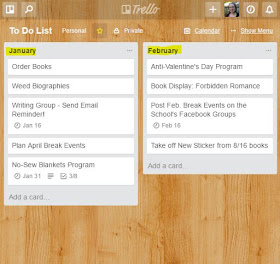When I first tried it out, I wasn't sure what was the best way to use it, But after a year, I now have a system in place that has worked really well. If you are curious about Trello, want to organize your life better, or see how an online organizer could work in a library setting, this post is for you!
1. Make a Column for Each Month
I have 12 columns (called "lists"), one for each month. I added tasks (called "cards") to each month to remind myself what needs to be done. As new tasks come up, I add them to the list. Anything that was a one time deal, I archive/delete when I complete it. If it is a yearly task, I move it to the bottom of my list so I know it is done, but it remains on my list for next year. For example, I would always forget that my Director asks for my program numbers in August for her yearly report. So, in May (my last "quiet month" before the Summer Reading craziness) and in July (to catch my Summer Reading stats), I give myself a task to make sure I have a list typed up with all of my numbers. Now, when August comes around, I'll be expecting her to ask AND I already have the work done, completed at a time that's best for me.
2. Utilize the Deadlines Feature
You can enable Deadlines on your tasks. When you get close to the due date, Trello will email you a reminder. The deadline will also turn to yellow when it is due in 24 hours and then red after the deadline has passed, so you can easily see at a glance what you need to get done for the day. Recently, Trello has added a feature in which you can cross out a deadline after you complete it, so you can now see your progress, too, on the calendar as a strike-out.
3. Streamline to Decrease Clutter
I have learned two simple ways to decrease clutter and help me plan ahead. Trello recommends that you make a column to move your completed tasks, but I don't do that. When I complete that month's task, I add it to the bottom of the list for next year. If it is a reoccurring task (say a reminder to email members that your monthly meeting is coming up next week), I update the deadline and then move it into the next month's column. So when I look ahead, I don't see these minute tasks and can easily plan around my big projects.My second recommendation is to utilize their Checklist feature. For tasks that have multiple steps, I make just one task and add a checklist breaking it down into smaller parts. You can even make generic checklists so you aren't constantly creating a new one. For example, I have a generic checklist for programs. When I create a new program, I can pull up my Program Checklist and it will fill in with my advertising, material shopping, etc. and then I can customize it for specifics.
4. Plan Ahead for Next Year
I add new tasks to each month as they come up. If it was a one time task, I delete it when I complete it. If I need to do it yearly, I leave it in that month's queue (dragged to the end of the list) and update the deadline for next year. When the month ends, I move the whole column to the end (far right). Now my first month in the list would be February and January 2018 is already planned out.
These tips can really work for almost any other program (Google Calendar, Asana, and others!) and you can also do some of them with a paper calendar. For my daily tasks, I do reference my Trello board and then write them down on paper. So, feel free to mix and match online and paper techniques. It doesn't matter how you do it, just that you find a process that works for you.
5. Collaborate with Your Colleagues
Trello allows you to share your boards with anyone. In my previous job, I had a Teen Staff board and an All Library Board, sharing it with the appropriate people. We could work together to shelf read sections of the library (we had a task for each section and people wrote where they ended in that section), build book display lists, keep track of when we pulled off the new book sticker. Every time someone posts, it is time stamped. There is also an option to write comments to each other (you can also tag specific people) and attach documents.These tips can really work for almost any other program (Google Calendar, Asana, and others!) and you can also do some of them with a paper calendar. For my daily tasks, I do reference my Trello board and then write them down on paper. So, feel free to mix and match online and paper techniques. It doesn't matter how you do it, just that you find a process that works for you.








No comments:
Post a Comment